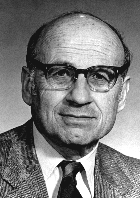
Most of the biographies and pictures on this page were taken from the MacTutor History of Mathematics Archive.

Born: 1923 in Vienna, Austria.
Walter Kohn received the Nobel prize for Chemistry in 1998, mainly for his many ground-breaking contributions to Density-Functional Theory. You can read about him on the Nobel prize site.
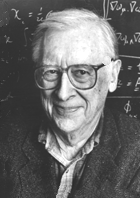
Born: 31 October 1925 in Burnham-on-Sea, Somerset.
John Kohn received the Nobel prize for Chemistry in 1998, for the tremendous work he has done over the years making computational chemistry into a powerful, flexible method for use by all sorts of chemists. You can read about him on the Nobel prize site.
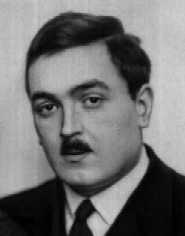
Born: 22 December 1898 in St Petersburg, Russia.
Died: 27 December 1974 in St Petersburg, Russia.
Vladimir A.Fock was born on 22 December 1998 in StPeterburg and died in the same town on 27 december 1974. He graduated from StPetersburg (Petrograd) University and, with exception of war and several post war years, his life was associated with St.Peterburg (Leningrad) where he was teaching at the University for more than 40 years. During this time he made fundamental contributions to quantum theory reflected in such notions as Fock space, Hartree--Fock method and others.

Born: 25 December 1904 in Hamburg, Germany
Died: 1999
Gerhard Herzberg was born in Hamburg, Germany, on 25 December,
1904. He was married in 1929 to Luise Herzberg neé Oettinger
and has two children. He was widowed in 1971.
Herzberg received his early training in Hamburg and subsequently
studied physics at the Darmstadt Institute of Technology where in
1928 he obtained his Dr. Ing. degree under H. Rau (a pupil of W.
Wien). From 1928 to 1930 he carried out post-doctorate work at the
University of Göttingen under James
Franck and Max Born and the
University of Bristol. In 1930
he was appointed Privatdozent (lecturer) and senior assistant in
the Physics Department of the Darmstadt Institute of Technology.
In August 1935 Herzberg was forced to leave Germany as a refugee
and took up a guest professorship at the University
of Saskatchewan (Saskatoon, Canada), for which funds had been
made available by the Carnegie Foundation. A few months later he
was appointed research professor of physics, a position he held
until 1945. From 1945 to 1948 Herzberg was professor of spectroscopy
at the Yerkes Observatory of the University
of Chicago. He returned to Canada in 1948 and was made Principal
Research Officer and shortly afterwards Director of the Division
of Physics at the National Research Council. In 1955, after the
Division had been divided into one in pure and one in applied physics,
Herzberg remained Director of the Division of Pure Physics, a position
which he held until 1969 when he was appointed Distinguished Research
Scientist in the recombined Division of Physics.
Herzberg's main contributions are to the field of atomic and molecular
spectroscopy. He and his associates have determined the structures
of a large number of diatomic and polyatomic molecules, including
the structures of many free radicals difficult to determine in any
other way (among others, those of free methyl and methylene). Herzberg
has also applied these spectroscopic studies to the identification
of certain molecules in planetary atmospheres, in comets, and in
interstellar space.
Herzberg has been active as President or Vice President of several
international commissions dealing with spectroscopy. He was also
Vice President of the International Union of Pure and Applied Physics
from 1957 to 1963. He held the offices of President of the Canadian
Association of Physicists for the year 1956-57 and President of
the Royal Society of Canada for
the year 1966-67.
Herzberg was elected a Fellow of the Royal Society of Canada in
1939 and of the Royal Society of London in 1951. He was Bakerian
Lecturer of the Royal Society of London in 1960 and received a Royal
Medal from the Society in 1971. He was George Fischer Baker Non-Resident
Lecturer in Chemistry at Cornell
University in 1968, and Faraday Medallist and Lecturer of the
Chemical Society of London in 1970. He is Honorary Member or Fellow
of a number of scientific societies, including the American Academy
of Arts and Sciences, the Optical Society of America and the Chemical
Society. He is also a Foreign Associate of the National
Academy of Sciences in Washington and a member of the Pontifical
Academy of Sciences. He is a Companion of the Order of Canada. He
has received many other medals and awards and holds Honorary Degrees
from a number of universities in Canada and abroad, including one
from the University of Stockholm.
Dr Herzberg was the laureate of the Nobel Prize for Chemistry in 1971 and died in 1999
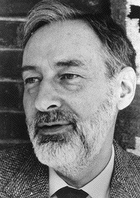
Born: 1910 in Graveland, Netherlands
Died: 1986
Koopmans won the Nobel Prize in Economics in 1975, together with Leonid Kantorovich, of the USSR,
"for their contributions to the theory of optimum allocation of resources."
He did his PhD with Hans Kramers in Utrecht, in the field of theoretical physics - this is when he did the work on what was subsequently called Koopmans' theorem. As he wrote in himself:
Below, I cite my one publication in quantum mechanics so that I can add here that Kramers's generosity and my inexperience combined to prevent his being listed as co-author of that paper. He should have been, because, although the main proposition was my own idea, Kramers, besides guiding the writing, also supplied the proof!
After his PhD, he shifted subjects to mathematical economics. You can read his autobiographical sketch on the website of the Nobel Foundation.
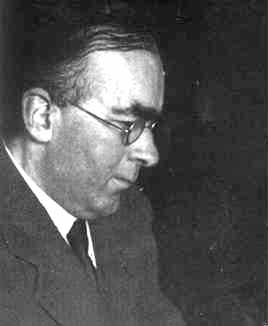
Born: 27 March 1897 in Cambridge, Cambridgeshire, England
Died: 12 Feb 1958 in Cambridge, Cambridgeshire, England
Douglas Hartree's school education was in Cambridge and Petersfield. He entered St John's College Cambridge in 1915 but World War I interrupted his studies and he joined a team studying anti-aircraft gunnery.
He returned to Cambridge after the war and graduated in 1921 but, perhaps because of his interrupted studies, he only obtained a Second Class degree in Natural Sciences. However he went on to obtain a doctorate in 1926 and, after being a Fellow of St John's College (1924-27) and Christ's College (1928-29) he was appointed professor of applied mathematics at Manchester.
Hartree held this chair from 1929 to 1937 when he moved to the chair of theoretical physics. After undertaking work with the Ministry of Supply during World War II, he was appointed Plummer Professor of Mathematical Physics at Cambridge. He held this post until his death.
Hartree was basically a theoretical physicist, and he developed powerful methods in numerical analysis. His initial interest in numerical methods arose from his work on anti-aircraft gunnery in 1916-18. However Niels Bohr gave a lecture course in Cambridge in 1921 and Hartree was much influenced, working on applications of numerical methods for integrating differential equations to calculate atomic wave functions.
Hartree learned of a differential analyzer being developed by Vannevar Bush in the USA. This machine, first proposed by Lord Kelvin (William Thomson), performs integration with a wheel rolling on a rotating disk. Hartree visited Boston to learn about the workings of the differential analyzer, then returned to Cambridge and built his own.
The differential analyzer was soon to be replaced by electronic computers and when John Eckert set up ENIAC, Hartree was asked to go to the USA to advise on its use. He showed how to use ENIAC to calculate trajectories of projectiles. In his inaugural address on his appointment to the chair in Cambridge in 1946 he said
It may well be that the high-speed digital computer will have as great an influence on civilization as the advent of nuclear power.
In addition to applying numerical methods to ballistics Hartree applied them to the physics of the atmosphere and to hydrodynamics.
He wrote a number of important books including Numerical analysis in 1952. In this book he says
Anyone intending to undertake a serious piece of calculation should realise that adequate checking against mistakes is an essential part of any satisfactory numerical process. No one, and no machine, is infallible, and it may fairly be said that the ideal to aim at is not to avoid mistakes entirely, but to find all mistakes that are made, and so free the work from any unidentified mistakes.
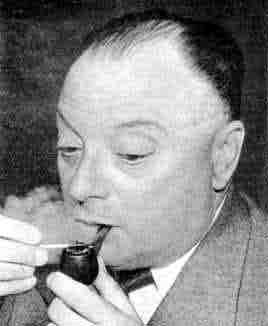
Born: 25 April 1900 in Vienna, Austria
Died: 15 Dec 1958 in Zurich, Switzerland
Wolfgang Pauli was the son of a medical doctor who was himself to become a university professor. Wolfgang attended school in Vienna where he began a deep study of mathematics and physics. He entered the University of Munich in 1918 and, while still an undergraduate at Munich, wrote an article on the theory of relativity which became the standard text.
At Munich, Pauli was taught by Sommerfeld who soon recognised his genius. This genius was also recognised by Einstein who, after reading Pauli's article on relativity, wrote:-
Whoever studies this mature and grandly conceived work might not believe that its author is a twenty-one year old man.
Pauli, writing about his days as a student at Munich, wrote:-
I was not spared the shock which every physicist accustomed to the classical way of thinking experienced when he came to know Niels Bohr's basic postulate of quantum theory for the first time.
He wrote on atomic physics beginning in 1920 and Pauli received his doctorate, supervised by Sommerfeld, for a thesis on the quantum theory of ionised molecular hydrogen. He was then appointed to Göttingen as Born's assistant. It was in Göttingen that he first met Niels Bohr in person and he wrote:-
... a new phase of my scientific life began when I first met Niels Bohr personally for the first time. During these meetings, Bohr asked me whether I could come to Copenhagen for a year.
Pauli eagerly accepted the invitation and spent the year 1922-23 at Bohr's Institute. In 1923, he was appointed a lecturer at Hamburg, then in 1924 he proposed a quantum spin number for electrons.
Pauli is best known for the Pauli exclusion principle, proposed in 1928, which states that no two electrons in an atom can have the same four quantum numbers.
In 1928 Pauli was appointed professor at Zurich. He noticed that the laws of energy, spin and momentum seemed to be violated in beta-decay and postulated the existence of a hitherto unobserved elusive particle. This was later called the neutrino following a suggestion of Fermi. Three varieties of neutrino were later found experimentally.
In 1940 Pauli was appointed to the chair of theoretical physics at Princeton then he returned to Zurich after World War II. He was awarded the Nobel Prize in 1945.
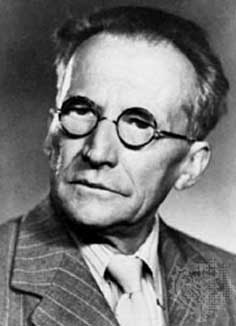
Born: 12 Aug 1887 in Erdberg, Vienna, Austria
Died: 4 Jan 1961 in Vienna, Austria
Erwin Schrödinger's father Rudolf Schrödinger ran a small linoleum factory which he had inherited from his own father. Erwin's grandmother, Emily Bauer, was half English, this side of the family coming from Leamington Spa, and half Austrian with her father coming from Vienna.
Schrödinger learnt English and German almost at the same time due to the fact that both were spoken in the household. He was not sent to elementary school, but received lessons at home from a private tutor up to the age of ten. He entered the Akademisches Gymnasium in the autumn of 1898, rather later than was usual since he spent a long holiday in England around the time he might have entered the school. He wrote later about his time at the Gymnasium:-
I was a good student in all subjects, loved mathematics and physics, but also the strict logic of the ancient grammars, hated only memorising incidental dates and facts. Of the German poets, I loved especially the dramatists, but hated the pedantic dissection of this works.
In [15] there is the following quotation from a student in Schrödinger's class at school:-
Especially in physics and mathematics, Schrödinger had a gift for understanding that allowed him, without any homework, immediately and directly to comprehend all the material during the class hours and to apply it. After the lecture ... it was possible for [our professor] to call Schrödinger immediately to the blackboard and to set him problems, which he solved with playful facility.
Schrödinger graduated in 1906 and, in that year, entered the University of Vienna. In theoretical physics he studied analytical mechanics, applications of partial differential equations to dynamics, eigenvalue problems, Maxwell's equations and electromagnetic theory, optics, thermodynamics and statistical mechanics. It was Fritz Hasenöhrl's lectures on theoretical physics which had the greatest influence on Schrödinger. In mathematics he was taught calculus and algebra by Franz Mertens, function theory, differential equations and mathematical statistics by Wilhelm Wirtinger (who he found uninspiring as a lecturer). He also studied projective geometry, algebraic curves and continuous groups in lectures by Gustav Kohn.
On 20 May 1910, Schrödinger was awarded his doctorate with a doctoral dissertation On the conduction of electricity on the surface of insulators in moist air. After this he undertook voluntary military service in the fortress artillery. Then he was appointed to an assistantship at Vienna but, rather surprisingly, in experimental physics rather than theoretical physics. He later said that his experiences conducting experiments proved an invaluable asset to his theoretical work since it gave him a practical philosophical framework in which to set his theoretical ideas.
Having completed the work for his habilitation, he was awarded the degree on 1 September 1914. That it was not an outstanding piece of work is shown by the fact that the committee was not unanimous in recommending him for the degree. As Moore writes in [7]:-
Schrödinger's early scientific work was inhibited by the absence of a group of first-class theoreticians in Vienna, against whom he could sharpen his skills by daily argument and mutual criticism.
In 1914 Schrödinger's first important paper was published developing ideas of Boltzmann. However, with the outbreak of World War I, Schrödinger received orders to take up duty on the Italian border. His time of active service was not useless as far as research was concerned and he continued his theoretical work, submitting another paper from his position on the Italian front. In 1915 he was transferred to duty in Hungary and from there he submitted further work for publication. After being sent back to the Italian front, Schrödinger received a citation for outstanding service commanding a battery during a battle.
In the spring of 1917 Schrödinger was sent back to Vienna, assigned to teach a course in meteorology. He was able to continue research and he published his first results on quantum theory. After the end of the war he continued working at Vienna. From 1918 to 1920 he made substantial contributions to colour theory.
Schrödinger had worked at Vienna on radioactivity, proving the statistical nature of radioactive decay. He had also made important contributions to the kinetic theory of solids, studying the dynamics of crystal lattices. On the strength of his work he was offered an associate professorship at Vienna in January 1920 but by this time he wished to marry Anny Bertel. They had become engaged in 1919 and Anny had come to work as a secretary in Vienna on a monthly salary which was more than Schrödinger's annual income. He was offered an associate professorship, still not at a salary large enough to support a non-working wife so he declined.
Schrödinger accepted instead an assistantship in Jena and married Anny on 24 March 1920. After only a short time there, he moved to a chair in Stuttgart where he became friendly with Hans Reichenbach. He then moved to a chair in Breslau, his third move in eighteen months. Soon however he was to move yet again, accepting the chair of theoretical physics at Zurich in late 1921. During these years of changing from one place to another, Schrödinger studied physiological optics, in particular he continued his work on the theory of colour vision.
Weyl was Schrödinger's closest colleague in his first years in Zurich and he was to provide the deep mathematical knowledge which would prove so helpful to Schrödinger in his work. The intellectual atmosphere in Zurich suited Schrödinger and Zurich was to be the place where he made his most important contributions. From 1921 he studied atomic structure. Then in 1924 he began to study quantum statistics, soon after this he read de Broglie's thesis which was to have a major influence on his thinking. On 3 November 1925 Schrödinger wrote to Einstein:-
A few days ago I read with great interest the ingenious thesis of Louis de Broglie, which I finally got hold of...
On 16 November, in another letter, Schrödinger wrote:-
I have been intensely concerned these days with Louis de Broglie's ingenious theory. It is extraordinarily exciting, but still has some very grave difficulties.
One week later Schrödinger gave a seminar on de Broglie's work and a member of the audience, a student of Sommerfeld's group suggested that there should be a wave equation. Within a few weeks Schrödinger had found his wave equation.
Schrödinger published his revolutionary work relating to wave mechanics and the general theory of relativity in a series of six papers in 1926. Wave mechanics, as proposed by Schrödinger in these papers, was the second formulation of quantum theory, the first being matrix mechanics due to Heisenberg. The relation between the two formulations (wave mechanics and matrix mechanics) was understood by Schrödinger immediately as this quotation from one of his 1926 papers shows:-
To each function of the position- and momentum- coordinates in wave mechanics there may be related a matrix in such a way that these matrices in every case satisfy the formal calculation rules of Born and Heisenberg. ... The solution of the natural boundary value problem of this differential equation in wave mechanics is completely equivalent to the solution of Heisenberg's algebraic problem.
The work was indeed received with great acclaim. Planck described it as
epoch-making work.
Einstein wrote:-
... the idea of your work springs from true genius...
Then, ten days later Einstein wrote again:-
I am convinced that you have made a decisive advance with your formulation of the quantum condition...
Ehrenfest wrote:-
I am simply fascinated by your [wave equation] theory and the wonderful new viewpoint it brings. Every day for the past two weeks our little group has been standing for hours at a time in front of the blackboard in order to train itself in all the splendid ramifications.
Schrödinger accepted an invitation to lecture at the University of Wisconsin, Madison leaving in December 1926 to give his lectures in January and February 1927. Before he left he was told he was the leading candidate for Planck's chair in Berlin. After giving a brilliant series of lectures in Madison he was offered a permanent professorship there but [7]:-
... he was not at all tempted by an American position, and he declined on the basis of a possible commitment to Berlin.
The list of candidates to succeed Planck in the chair of theoretical physics at Berlin was impressive. Sommerfeld was ranked in first place, followed by Schrödinger, with Born as the third choice. When Sommerfeld decided not to leave Munich, the offer was made to Schrödinger. He went to Berlin, taking up the post on 1 October 1927 and there he became a colleague of Einstein's.
Although he was a Catholic, Schrödinger decided in 1933 that he could not live in a country in which persecution of Jews had become a national policy. Alexander Lindemann, the head of physics at Oxford University, visited Germany in the spring of 1933 to try to arrange positions in England for some young Jewish scientists from Germany. He spoke to Schrödinger about posts for one of his assistants and was surprised to discover that Schrödinger himself was interested in leaving Germany. Schrödinger asked for a colleague, Arthur March, to be offered a post as his assistant.
To understand Schrödinger's request for March we must digress a little and comment on Schrödinger's liking for women. His relations with his wife had never been good and he had had many lovers with his wife's knowledge. Anny had her own lover for many years, Schrödinger's friend Weyl. Schrödinger's request for March to be his assistant was because, at that time, he was in love with Arthur March's wife Hilde.
Many of the scientists who had left Germany spent the summer of 1933 in the South Tyrol. Here Hilde became pregnant with Schrödinger's child. On 4 November 1933 Schrödinger, his wife and Hilde March arrived in Oxford. Schrödinger had been elected a fellow of Magdalen College. Soon after they arrived in Oxford, Schrödinger heard that, for his work on wave mechanics, he had been awarded the Nobel prize.
In the spring of 1934 Schrödinger was invited to lecture at Princeton and while there he was made an offer of a permanent position. On his return to Oxford he negotiated about salary and pension conditions at Princeton but in the end he did not accept. It is thought that the fact that he wished to live at Princeton with Anny and Hilde both sharing the upbringing of his child was not found acceptable. The fact that Schrödinger openly had two wives, even if one of them was married to another man, did not go down too well in Oxford either but his daughter Ruth Georgie Erica was born there on 30 May 1934.
In 1935 Schrödinger published a three-part essay on The present situation in quantum mechanics in which his famous Schrödinger's cat paradox appears. This was a thought experiment where a cat in a closed box either lived or died according to whether a quantum event occurred. The paradox was that both universes, one with a dead cat and one with a live one, seemed to exist in parallel until an observer oped the box.
In 1936 Schrödinger was offered the chair of physics at the University of Edinburgh in Scotland. He may have accepted that post but for a long delay in obtaining a work permit from the Home Office. While he was waiting he received an offer from the University of Graz and he went to Austria and spent the years 1936-1938 in Graz. Born was then offered the Edinburgh post which he quickly accepted.
However the advancing Nazi threat caught up with Schrödinger again in Austria. After the Anschluss the Germans occupied Graz and renamed the university Adolf Hitler University. Schrödinger wrote a letter to the University Senate, on the advice on the new Nazi rector, saying that he had:-
... misjudged up to the last the true will and the true destiny of my country. I make this confession willingly and joyfully...
It was a letter he was to regret for the rest of his life. He explained the reason to Einstein in a letter written about a year later:-
I wanted to remain free - and could not do so without great duplicity.
The Nazis could not forget the insult he had caused them when he fled from Berlin in 1933 and on 26 August 1938 he was dismissed from his post for 'political unreliability'. He went to consult an official in Vienna who told him that he must get a job in industry and that he would not be allowed to go to a foreign country. He fled quickly with Anny, this time to Rome from where he wrote to de Valera as President of the League of Nations. De Valera offered to arrange a job for him in Dublin in the new Institute for Advanced Studies he was trying to set up. From Rome Schrödinger went back to Oxford, and there he received an offer of a one year visiting professorship at the University of Gent.
After his time in Gent, Schrödinger went to Dublin in the autumn of 1939. There he studied electromagnetic theory and relativity and began to publish on a unified field theory. His first paper on this topic was written in 1943. In 1946 he renewed his correspondence with Einstein on this topic. In January 1947 he believed he had made a major breakthrough [7]:-
Schrödinger was so entranced by his new theory that he threw caution to the winds, abandoned any pretence of critical analysis, and even though his new theory was scarcely hatched, he presented it to the Academy and to the Irish press as an epoch-making advance.
The Irish Times carried an interview with Schrödinger the next day in which he said:-
This is the generalisation. Now the Einstein Theory becomes simply a special case... I believe I am right, I shall look an awful fool if I am wrong.
Einstein, however, realised immediately that there was nothing of merit in Schrödinger's 'new theory' [7]:-
[Schrödinger] was even thinking of the possibility of receiving a second Nobel prize. In any case, the entire episode reveals a lapse in judgment, and when he actually read Einstein's comment, he was devastated.
Einstein wrote immediately breaking off the correspondence on unified field theory. Unified field theory was, however, not the only topic to interest him during his time at the Institute for Advanced Study in Dublin. His study of Greek science and philosophy is summarised in Nature and the Greeks (1954) which he wrote while in Dublin. Another important book written during this period was What is life (1944) which led to progress in biology.
On the personal side Schrödinger had two further daughters while in Dublin, to two different Irish women. He remained in Dublin until he retired in 1956 when he returned to Vienna and wrote his last book Meine Weltansicht (1961) expressing his own metaphysical outlook.
During his last few years Schrödinger remained interested in mathematical physics and continued to work on general relativity, unified field theory and meson physics.
Back to the list of online lectures.
Forward to Section 0